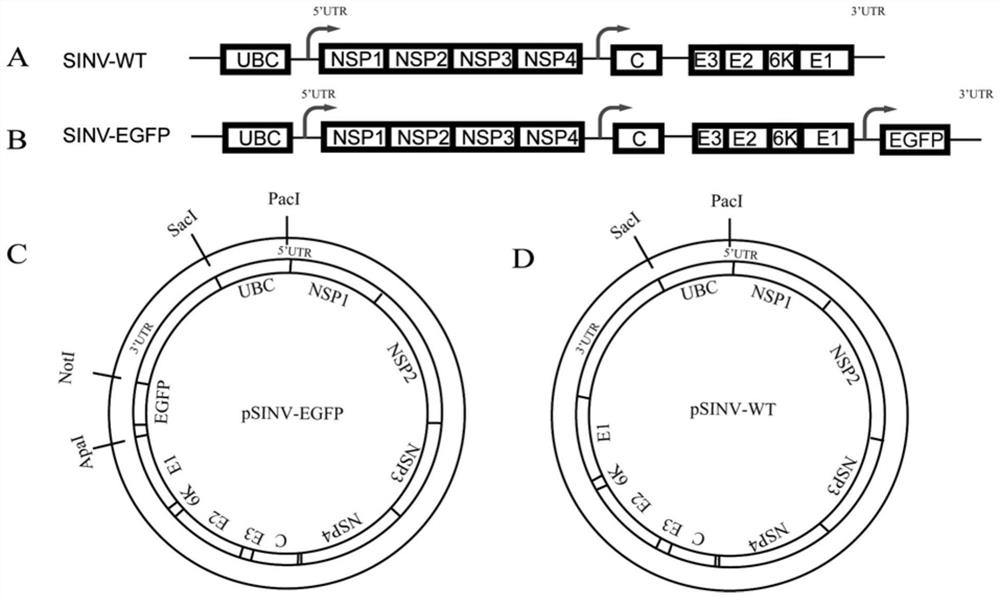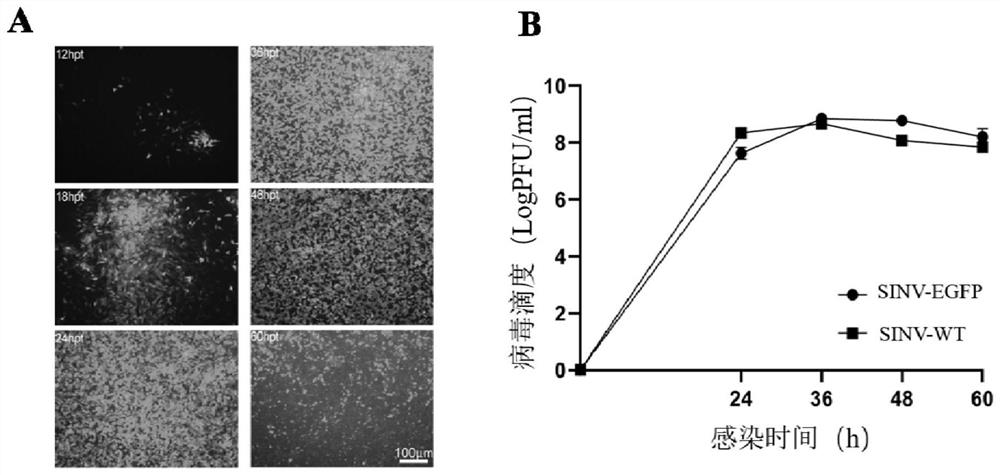Sindbis virus vector and virus particles thereof, and application of Sindbis virus vector and virus particles thereof in neural circuit
A technology of virus vectors and virus particles, applied in Sindbis virus vectors and their virus particles, and in the application field of neural circuits, can solve the problems of cumbersome steps, complicated operations, and no application of primate neural circuits, etc., to achieve Effect of saving time and operation steps
- Summary
- Abstract
- Description
- Claims
- Application Information
AI Technical Summary
Problems solved by technology
Method used
Image
Examples
Embodiment 1
[0031] The Sindbis virus vector of the present invention is prepared through the following steps:
[0032] SINV-WT (structure such as figure 1 Shown in A and 1D) and SINV-EGFP (structure such as figure 1 Shown in B and 1C) all start the transcription and translation of virus structural protein and nonstructural protein by UBC promoter, complete the packaging of virus. The primer amplification fragment shown in SEQ ID NO.2 and SEQ ID NO.3 was used to amplify the UBC promoter SEQ ID NO.4, which was inserted into the vector by SacI and PacI. Use the primers shown in SEQ ID NO.5 and SEQ ID NO.6 to amplify the EGFP gene fragment SEQ ID NO.7, the EGFP gene is initiated by the second viral subgenome promoter (26S) on the SINV vector, using SEQ ID NO. 8 and the primers shown in SEQ ID NO.9 amplified 26S, and fused with the EGFP gene in a DNA fragment (ie, SEQ ID NO.10), which was inserted into the vector via ApaI and NotI.
[0033] The PCR reaction system is 50μl: 5×Reaction Buffer...
Embodiment 2
[0037] Fluorescent expression and one-step growth curve after Sindbis virus vector transfection carrying EGFP gene of the present invention:
[0038] After extracting the SINV-EGFP plasmid of Example 1 with a plasmid extraction kit, transfect BHK-21 cells with lipofectamine 2000, 37°C, 5% (v / v) CO 2 Cultivate in an incubator to infect BHK-21 cells with the virus, and observe the cell state and fluorescence expression through an inverted fluorescence microscope at different time points. The results are as follows: figure 2 As shown in A, a green fluorescent signal can be produced after 12 hours, indicating that the Sindbis virus vector can successfully package the SINV virus and express the foreign protein efficiently and rapidly. A part of the virus supernatant collected at different time points was subpackaged, and a part was taken to detect the virus titer of the supernatant collected at different time points by double-layer plaque method, and a one-step growth curve was dr...
Embodiment 3
[0040] The Sindbis virus particles prepared in Example 2 infect various cells cultured in vitro, and can replicate and spread in the cells:
[0041] Infect the virus supernatant collected in Example 2 in BHK-21 cells and primary cultured neuronal cells respectively, take 5 μ l of the supernatant 2 days after transfection and infect the primary cultured neuronal cells and BHK-21 cells, in The expression of green fluorescence was observed 1 day (24 hours) after infection. The result is as image 3 as shown, image 3 A is the primary cultured neuron cells, image 3 B is BHK-21 cells. Embodiment 2 has proved that the Sindbis virus vector of the present invention can transfect BHK-21 cells to produce Sindbis virus particles, so image 3 The result of B can be used as a positive control. image 3 The BHK-21 cells in B are all infected by Sindbis virus and express green fluorescence, which further verifies that the Sindbis virus can infect and replicate in BHK-21 cells. image ...
PUM
 Login to View More
Login to View More Abstract
Description
Claims
Application Information
 Login to View More
Login to View More - R&D
- Intellectual Property
- Life Sciences
- Materials
- Tech Scout
- Unparalleled Data Quality
- Higher Quality Content
- 60% Fewer Hallucinations
Browse by: Latest US Patents, China's latest patents, Technical Efficacy Thesaurus, Application Domain, Technology Topic, Popular Technical Reports.
© 2025 PatSnap. All rights reserved.Legal|Privacy policy|Modern Slavery Act Transparency Statement|Sitemap|About US| Contact US: help@patsnap.com



